 In the late 1999 months there was some gossip among the Mechanics community of
the school in the sense that the turbojet Rolls-Royce Derwent V
that was in the Engines' Laboratory had been started sometime by somebody. We fulfill in
remembering that on December 10th of 1982 a group of students of
6th. Year 1st Division of the Mechanics Specialty; concretely:
Gabriel Donvito, Gustavo Olivato, Guillermo Puma, and Gustavo D.
Vranjes, were the authors of such fact.
In the late 1999 months there was some gossip among the Mechanics community of
the school in the sense that the turbojet Rolls-Royce Derwent V
that was in the Engines' Laboratory had been started sometime by somebody. We fulfill in
remembering that on December 10th of 1982 a group of students of
6th. Year 1st Division of the Mechanics Specialty; concretely:
Gabriel Donvito, Gustavo Olivato, Guillermo Puma, and Gustavo D.
Vranjes, were the authors of such fact.
In that occasion four people of 17 years old with the aid of Mr. Néstor Turró, then member of the Laboratory of Electrical Measurements, carried out the enterprise since October 17th of 1982, in only 53 days and at least 219 hs. of work accounted. Among other things, the most remarkable of them were:
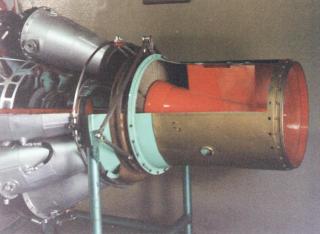
1. To obtain the maintenance and starting manuals of the engine thanks
to Fuerza Aerea Argentina's Brigadier, Mr. Aubone, then Director of the
National Aeronautics' Library and Mrs. María Julia Fernández,
then leader of Librarians.
We also paid several visits to UTN Regional Medrano (National Technological University), Aerolíneas Argentinas'
airline maintenance workshops, Taller Regional Quilmes Technical School
and Jorge Newbery Technical School where we could see the motor in cutaway and receive
ample advising on its operation.
In each case we must emphasize the amiability and the excellent predisposition towards us.
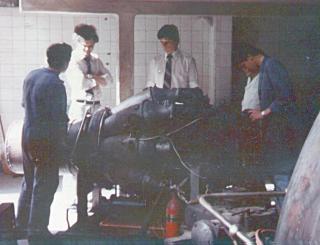 2. To review the state of the engine accompanied by Fuerza Aerea Argentina's
Suboficial Mayor, Mr. Alemán; who worked for years with this machine;
and since October 26th, to dissasemble it completely and remount it piece by piece
to make sure that there were no problems outside our visual reach.
2. To review the state of the engine accompanied by Fuerza Aerea Argentina's
Suboficial Mayor, Mr. Alemán; who worked for years with this machine;
and since October 26th, to dissasemble it completely and remount it piece by piece
to make sure that there were no problems outside our visual reach.
This may be the most discussed action to be taken; but the curiosity to
know the internal state of the machine could more...
3. To identify the missing pieces (fuel pumps, ignition system,
tachometer, jet exhaust tube and thermocouples, original control system).
 4. To obtain donations of auxiliary ignition fuel pump, jet exhaust tube and fuel
(JP-1, 500 liters) by the Area Material Quilmes and a
generator for tachometer, another auxiliary ignition fuel pump by the
ENET Jorge Newbery, and thermocouple gentility of Aerolíneas Argentinas'
maintenance workshops.
4. To obtain donations of auxiliary ignition fuel pump, jet exhaust tube and fuel
(JP-1, 500 liters) by the Area Material Quilmes and a
generator for tachometer, another auxiliary ignition fuel pump by the
ENET Jorge Newbery, and thermocouple gentility of Aerolíneas Argentinas'
maintenance workshops.
 5. The disinterested aid of the School's Electrical Measurements Laboratory
(Mr. Néstor Turró) to replace the nonexistent ignition system with its respective
manual starting board.
5. The disinterested aid of the School's Electrical Measurements Laboratory
(Mr. Néstor Turró) to replace the nonexistent ignition system with its respective
manual starting board.
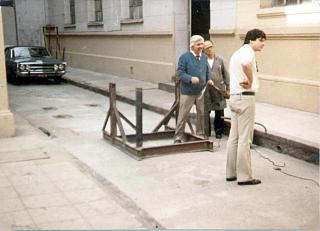 6. To construct a strong enough metallic base to support the
engine's weight (350 kgf approx.) and a sling to be able to raise and move it with
the aid of Mr. García, School's Blacksmith workshop teacher.
6. To construct a strong enough metallic base to support the
engine's weight (350 kgf approx.) and a sling to be able to raise and move it with
the aid of Mr. García, School's Blacksmith workshop teacher.
7. To move by hand the assembly (near 950 kgf total) by four 17 year old
aged people to an adequate place for the starting at 80 meters of the original
location of the engine.
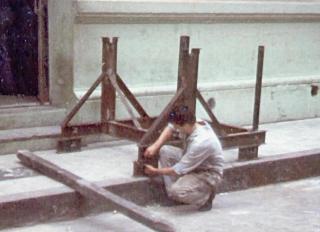 8. To perforate by hand 15 centimeters of concrete in one afternoon
in order to be able to make the four anchorages of the engine and to construct an elevated fuel
tank on the roof of the School's Materials Testing Laboratory to replace the missing
booster pump that could not be obtained.
8. To perforate by hand 15 centimeters of concrete in one afternoon
in order to be able to make the four anchorages of the engine and to construct an elevated fuel
tank on the roof of the School's Materials Testing Laboratory to replace the missing
booster pump that could not be obtained.
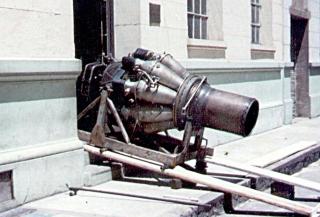 9. To count with the total support of School's Mechanics Superior Cycle
workshops Teachers (Mr. Gatti, Gonzalez, Seguí, Soto) and Professors of the
Specialty (Mr. Alvarez, Butera, Pietrafesa, Vozza); who gave us permission for
an almost full time dedication in three daily working periods from October 17th
to conclude the necessary works.
9. To count with the total support of School's Mechanics Superior Cycle
workshops Teachers (Mr. Gatti, Gonzalez, Seguí, Soto) and Professors of the
Specialty (Mr. Alvarez, Butera, Pietrafesa, Vozza); who gave us permission for
an almost full time dedication in three daily working periods from October 17th
to conclude the necessary works.
 10. That the authorities of the Establishment did not believe until the
last minute in the possibility of success of the enterprise.
We have to remember that in 1982 there was neither PC, Windows 98,
Autocad, Internet, Federal Law of Education nor Remote Studies that
could guarantee concrete results. We had neither the Happy Hour nor
celebrated Halloween. Also Torneos y Competencias did not exist to
to spread the event. Neither the President who could made it to be
possible.
10. That the authorities of the Establishment did not believe until the
last minute in the possibility of success of the enterprise.
We have to remember that in 1982 there was neither PC, Windows 98,
Autocad, Internet, Federal Law of Education nor Remote Studies that
could guarantee concrete results. We had neither the Happy Hour nor
celebrated Halloween. Also Torneos y Competencias did not exist to
to spread the event. Neither the President who could made it to be
possible.
Oh, man; those were very hard days indeed...
 Even when the 6th division of Mechanics was concurring to the Engines'
Laboratory from the beginning of the regular classes period, and that the
plate of the photography was always at sight; it was not until
the machine was recognized in a book of jet engines in the School's
Library, that was spoken for the first time and in a very informal
way of the intention of getting the turbojet running. After three or four days
of thinking better about it, a workgroup was created, and reaching the conclusion
that the goal to reach was almost impossible considering the available time
(and materials, as we would notice it later), it was decided to begin works
immediately from October 17th.
Even when the 6th division of Mechanics was concurring to the Engines'
Laboratory from the beginning of the regular classes period, and that the
plate of the photography was always at sight; it was not until
the machine was recognized in a book of jet engines in the School's
Library, that was spoken for the first time and in a very informal
way of the intention of getting the turbojet running. After three or four days
of thinking better about it, a workgroup was created, and reaching the conclusion
that the goal to reach was almost impossible considering the available time
(and materials, as we would notice it later), it was decided to begin works
immediately from October 17th.
 On November 22th they had been able to reach the regime of ignition (900
RPMs) with a lent car battery and on November 25th they run the first test
with the ignition torches fed by the same battery and an automobile ignition coil.
Tested each one independently, them seemed to work OK. When trying to make the
assembly work together it was found that several modifications had to be done on
the system, until on December 1st it was assumed that everything was working OK. It is necessary to remember again
that the ignition system practically did not exist, and that for
example they had to replace the car batteries for the turbojet's starter engine which they did not have at hand
by a DC welding generator of the School's Blacksmith workshop. Also they had to discard the automobile ignition coils
due to the lack of sufficient spark energy and we had to
replace it with Rumford coils lent by the School's Physics Laboratory.
On November 22th they had been able to reach the regime of ignition (900
RPMs) with a lent car battery and on November 25th they run the first test
with the ignition torches fed by the same battery and an automobile ignition coil.
Tested each one independently, them seemed to work OK. When trying to make the
assembly work together it was found that several modifications had to be done on
the system, until on December 1st it was assumed that everything was working OK. It is necessary to remember again
that the ignition system practically did not exist, and that for
example they had to replace the car batteries for the turbojet's starter engine which they did not have at hand
by a DC welding generator of the School's Blacksmith workshop. Also they had to discard the automobile ignition coils
due to the lack of sufficient spark energy and we had to
replace it with Rumford coils lent by the School's Physics Laboratory.
 On December 7th the electrical command board was finished and at least eight
starting attempts that did not succeed were made between that day and December
10th.
On December 7th the electrical command board was finished and at least eight
starting attempts that did not succeed were made between that day and December
10th.
The first sign of a possible starting was seeing the
flames of the ignition torches located in the horizontally opposite combustion
chambers and seeing how a ring of fire was forming when one after another
of the burners were ignited just after opening the fuel main valve.
(This was known from the tests that were made at the ENET Taller Regional
Quilmes on their Gloster Meteor Mk IV).
 Thus the first starting attempt finished in a JP1 bath due to badly connected
cut-off fuel valves. At the same time a loss of oil was detected that
continued bothering for the rest of afternoon. From the second attempt, and for about three or four times
the starting sequence as was specified by the manual was repeated without
seeing the flames of the ignition torches. It was decided to return to review
everything that was done and at least the loss of oil was solved.
Néstor Turró had already an idea about how to solve the problem and one of the
members of the group (G. Donvito) sentenced: "Tomorrow is the day... ". Enough
for December 9th.
Thus the first starting attempt finished in a JP1 bath due to badly connected
cut-off fuel valves. At the same time a loss of oil was detected that
continued bothering for the rest of afternoon. From the second attempt, and for about three or four times
the starting sequence as was specified by the manual was repeated without
seeing the flames of the ignition torches. It was decided to return to review
everything that was done and at least the loss of oil was solved.
Néstor Turró had already an idea about how to solve the problem and one of the
members of the group (G. Donvito) sentenced: "Tomorrow is the day... ". Enough
for December 9th.
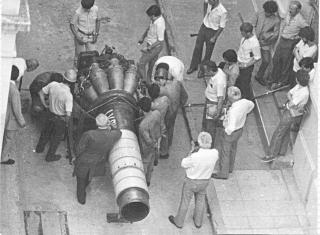 On December 10th there was the Studies' End Celebration where since
7:00 PM Diplomas would be given to the new Mechanical Technicians and it was
also the last day of 1982 regular classes period. The works began early and after
two attempts without success Néstor Turró exposed his thought about the problem:
The defective isolation of the spark plugs did not let the spark jump between
its electrodes (or at least
not with the necessary energy) and the deflagration of the fuel was
not caused.
On December 10th there was the Studies' End Celebration where since
7:00 PM Diplomas would be given to the new Mechanical Technicians and it was
also the last day of 1982 regular classes period. The works began early and after
two attempts without success Néstor Turró exposed his thought about the problem:
The defective isolation of the spark plugs did not let the spark jump between
its electrodes (or at least
not with the necessary energy) and the deflagration of the fuel was
not caused.
The only solution to the problem: to make new isolations! (and well
enough before 7:00 PM if there was to be another chance to attempt a starting
that day...)
At 10:00 AM, the chief of School's Mechanics Superior Cycle workshops, Mr. Alfredo Seguí
made these isolations from acrylic in only 30 minutes on the fly
following the precise instructions of Néstor Turró.
It was almost noon, everything was ready and the ignition sequence was launched
again with almost no hope. And another time the fire ring that precedes the
ignition was not seeing.
| End of the enterprise. All we had to do was to order everything and to prepare ourselves for the Celebration (celebration?) of Studies' End. |
We must emphasize that one meter behind the exhaust jet tube of Derwent V a stage was being arranged then for the same celebration in spite of repeated warnings... If somebody knows any better example of no Faith, send it to us in an email.
But G. Donvito, who without any doubt was the one with better "sense of smell" among all presents (never better applied the term) approached and engaged in dialog with G. Vranjes:
 And a last attempt was made. Same as the previous one. The fire in the
jet exhaust tube was not seen. But after all, if it was certain that there
was combustion the master valve of JP1 could be opened without problems; and if
there was not combustion, what would be lose by opening it?. Some more liters
of JP1?. It mattered no longer. After the use of strong words we can't repeat
in this page, the main fuel valve was opened and at 12:15 PM with a very smooth whistle the turbine
started and arrived by its own means to 3500 RPMs, with nobody still believing in what was happening.
There are not shots of this moment, although a photographic camera was near. The
few present persons were very busy with what they had at hand. These 3500 RPMs
were mantained by a minute approximately, and the chairs located behind the
exhaust jet tube were no longer there. The main valve of JP1 was closed to stop
the machine, and everything was reviewed (except the chairs...).
And a last attempt was made. Same as the previous one. The fire in the
jet exhaust tube was not seen. But after all, if it was certain that there
was combustion the master valve of JP1 could be opened without problems; and if
there was not combustion, what would be lose by opening it?. Some more liters
of JP1?. It mattered no longer. After the use of strong words we can't repeat
in this page, the main fuel valve was opened and at 12:15 PM with a very smooth whistle the turbine
started and arrived by its own means to 3500 RPMs, with nobody still believing in what was happening.
There are not shots of this moment, although a photographic camera was near. The
few present persons were very busy with what they had at hand. These 3500 RPMs
were mantained by a minute approximately, and the chairs located behind the
exhaust jet tube were no longer there. The main valve of JP1 was closed to stop
the machine, and everything was reviewed (except the chairs...).
 Soon at 12:30 PM the starting operation was repeated and the regime was raised
up to 6000 RPMs maintaining it by a pair of minutes. (Out of curiosity, neither in these two
nor in none of the startings that were done later the flames of the ignition
torches were seen...)
The noise of the machine was not unnoticed and the Principal
and personnel of School's Treasury and Secretariat come to observe the turbojet in action and
the scatter of the stage previously mounted.
The engine was shut off again to put everything in order as fast as could be
done, to make a small celebration in the Engines' Laboratory and to leave the
Establishment running to prepare for the (now yes) Studies' End Celebration
six hours later. During the Celebration the Principal mentioned what had
happened at noon without any commentaries about the necessity
to remount the stage that was behind the Derwent before being started...
Soon at 12:30 PM the starting operation was repeated and the regime was raised
up to 6000 RPMs maintaining it by a pair of minutes. (Out of curiosity, neither in these two
nor in none of the startings that were done later the flames of the ignition
torches were seen...)
The noise of the machine was not unnoticed and the Principal
and personnel of School's Treasury and Secretariat come to observe the turbojet in action and
the scatter of the stage previously mounted.
The engine was shut off again to put everything in order as fast as could be
done, to make a small celebration in the Engines' Laboratory and to leave the
Establishment running to prepare for the (now yes) Studies' End Celebration
six hours later. During the Celebration the Principal mentioned what had
happened at noon without any commentaries about the necessity
to remount the stage that was behind the Derwent before being started...
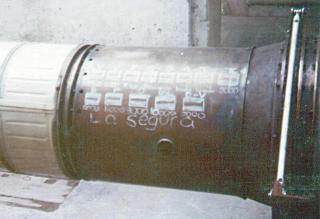 Between December 13th and December 22th the machine was able to reach a regime
of 11000 RPMs in a show open to the public, with relatives and
friends; 13 tests were performed altogether with complete success. Also Diego
Turró, younger brother of Néstor Turró; joined the group and two
years later he would became the best student of the Mechanics
Specialty. And although at its moment we did not have any film recording
equipment, we obtained an impressive mpg file of a running
Between December 13th and December 22th the machine was able to reach a regime
of 11000 RPMs in a show open to the public, with relatives and
friends; 13 tests were performed altogether with complete success. Also Diego
Turró, younger brother of Néstor Turró; joined the group and two
years later he would became the best student of the Mechanics
Specialty. And although at its moment we did not have any film recording
equipment, we obtained an impressive mpg file of a running
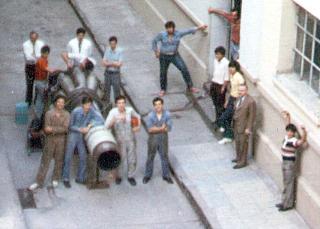 At almost twenty years of the event it is inevitable to think what
made it possible and wether it would be possible to be repeated
again today. Speaking about "the desire to do" is to simplify things grossly,
and many people, by convenience, or straighforward ignorance are adept
in these days to reduce all the problems to the lack of the first. On the
other hand, thinking that the result was simple a matter of luck is an
insult to everybody involved. It was necessary to make much work
in just a very short time and take the economic resources
(nonexistent) and the human ones (exceptional) to the limit, in
spite of the well-known "...it cannot be done". Without any doubt in this
last point (the one of exceptional human resources generated within
the School) there is the key of the matter to repeat and/or to improve
that enterprise. We wish from this page to give our most sincere gratefulness
to all those who made possible with their Faith and collaboration this adventure
come true.
At almost twenty years of the event it is inevitable to think what
made it possible and wether it would be possible to be repeated
again today. Speaking about "the desire to do" is to simplify things grossly,
and many people, by convenience, or straighforward ignorance are adept
in these days to reduce all the problems to the lack of the first. On the
other hand, thinking that the result was simple a matter of luck is an
insult to everybody involved. It was necessary to make much work
in just a very short time and take the economic resources
(nonexistent) and the human ones (exceptional) to the limit, in
spite of the well-known "...it cannot be done". Without any doubt in this
last point (the one of exceptional human resources generated within
the School) there is the key of the matter to repeat and/or to improve
that enterprise. We wish from this page to give our most sincere gratefulness
to all those who made possible with their Faith and collaboration this adventure
come true.